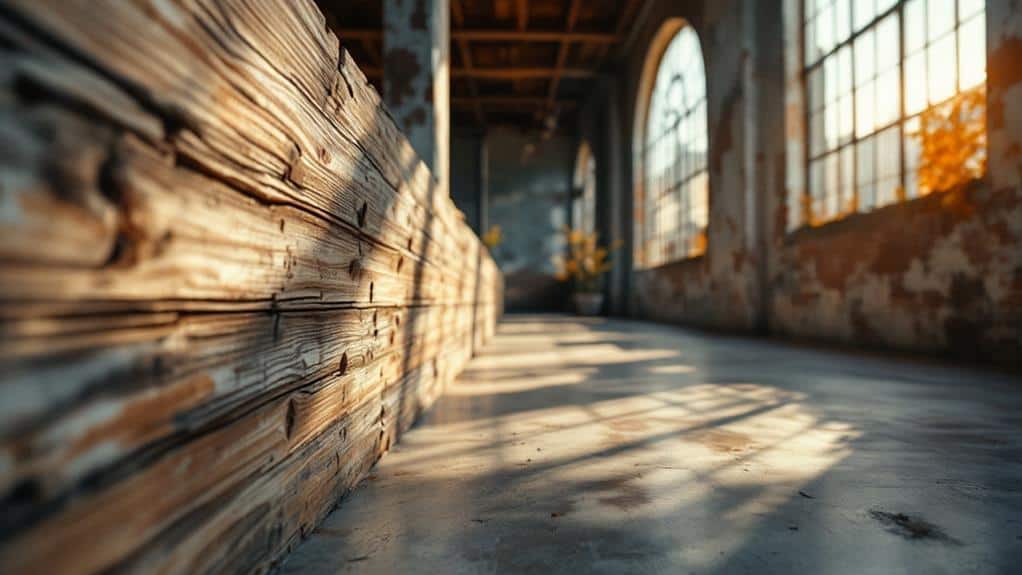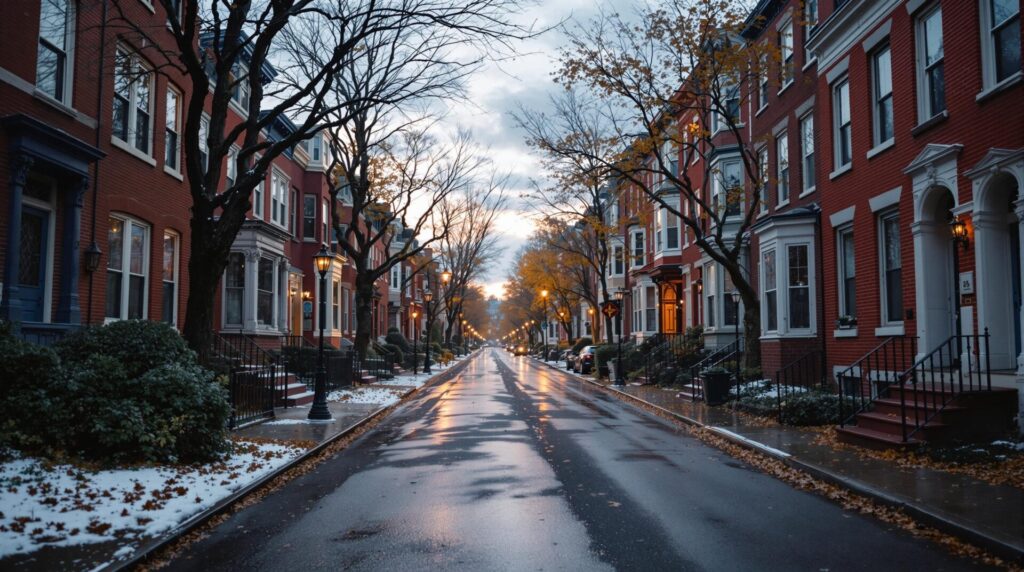Introduction: A New Era for Hidden Spaces
Imagine walking through a neighborhood and spotting a warehouse that, to the untrained eye, seems like an abandoned relic of the past.
You might be surprised to learn that these hidden gems are at the forefront of a real estate revolution.
Developers are transforming these overlooked spaces into vibrant hubs, blending historical charm with modern amenities.
As this trend gains momentum, you might wonder how these transformations impact communities and property values.
What could be next for these underutilized areas, and how might they shape the future of urban living?
Let's explore these questions further.
Converted Warehouses
Converted warehouses often provide an intriguing blend of history and modern living. You might be walking into a space that once housed bustling trade or storage, but now it offers a unique living environment brimming with character.
The concept of adaptive reuse brings these old structures back to life, transforming them from industrial relics into vibrant homes or workspaces. This process isn't just about preserving the past; it's about infusing new life into forgotten spaces, making them relevant and useful once more.
When you step inside a converted warehouse, you're likely to find high ceilings, expansive windows, and open floor plans that cater to a modern lifestyle. These spaces attract a creative community, people who appreciate the fusion of the old and the new.
This type of environment often fosters collaboration and innovation, providing a unique backdrop for work and play. The sense of community you'll find in these spaces is often strong, with residents and workers alike drawn to the shared history and unique architecture.
It's about creating a place where creativity and history coexist, providing a distinctive setting that enhances both personal and professional life.
Repurposed Factories
How do old factories transform into vibrant spaces that captivate the imagination? It's all about adaptive reuse and community engagement. You start by envisioning what these massive, often neglected structures can become, instead of what they were.
Picture a factory with towering ceilings and expansive rooms. Adaptive reuse breathes new life into these spaces, turning them into something functional and beautiful. With careful planning, these industrial giants can house anything from chic apartments to bustling art studios.
The heart of this transformation lies in understanding the needs of the community. Engage with local artists, entrepreneurs, and residents to discover what they envision for these spaces. Maybe there's a need for more affordable housing, or perhaps a cultural hub where people can gather and create.
By involving the community, you guarantee the space isn't just another building but a place people feel connected to.
You'll find that when a factory is successfully repurposed, it becomes more than just a physical structure. It turns into a cornerstone of the community, fostering creativity, collaboration, and growth.
This process not only revitalizes the building but also enriches the neighborhood, creating a lasting impact.
Tiny Homes Revolution
You're about to explore the exciting world of tiny homes, where sustainable living meets innovative design.
These compact spaces aren't just about downsizing; they offer clever solutions to maximize every square inch, making them perfect for eco-friendly and cost-effective living.
As you learn more, you'll see how tiny homes provide big possibilities with minimal environmental impact.
Sustainable Living Solutions
Amidst the growing demand for eco-friendly living, the tiny homes revolution offers a compelling solution for sustainable lifestyles. By embracing minimalism and efficiency, you can reduce your carbon footprint and live more harmoniously with nature.
These compact dwellings promote sustainable practices, like incorporating community gardens and vertical farming into your daily life. Imagine growing your own vegetables just steps from your door, cultivating a deeper connection with the earth.
Tiny homes encourage you to rethink your relationship with space and resources, emphasizing quality over quantity. They pave the way for a more sustainable future by focusing on renewable energy sources and water conservation methods.
Consider the benefits of solar panels and rainwater collection systems that make your home self-sufficient and eco-friendly.
Here are some key features of sustainable tiny living:
- Community gardens: Foster a sense of community while sharing fresh produce.
- Vertical farming: Grow your food efficiently in limited space.
- Energy efficiency: Embrace solar power and other renewable energy sources.
- Water conservation: Implement systems to reduce water usage.
- Minimalist design: Focus on essentials to reduce waste.
Maximizing Compact Spaces
When you embrace the tiny homes revolution, maximizing compact spaces becomes an art form that combines creativity with functionality. You start to see potential in every nook and cranny, transforming these small spaces into efficient, stylish sanctuaries.
One of the first steps is incorporating multifunctional furniture. Imagine a sofa that turns into a bed or a dining table that doubles as a desk. These pieces help you adapt your space to your needs without sacrificing style or comfort.
Vertical gardens are another powerful tool in your arsenal. By growing plants upwards instead of outwards, you save precious floor space while bringing nature indoors. These gardens can purify the air and provide fresh herbs for cooking, enhancing both your environment and lifestyle.
Consider using wall-mounted planters or hanging pots to create a lush, green tapestry that adds beauty and function to your home.
As you embark on this journey, remember that every square inch counts. Look for ways to use underutilized spaces, like installing shelves above doors or choosing furniture with built-in storage.
Micro-Apartments Trend
Picture a bustling cityscape where space is at a premium, and the solution lies in the innovative micro-apartments trend. These compact living spaces are becoming more popular as people seek affordable living options in areas with high urban density.
Micro-apartments cleverly maximize every square inch, making them ideal for those who want to enjoy city life without breaking the bank. Imagine living in a space that's not only cozy but also functional.
When you think about micro-apartments, consider the following benefits:
- Affordability: These units often come with lower rent and utility costs, helping you save money.
- Location: Being situated in the heart of the city means easy access to work, entertainment, and public transportation.
- Minimalism: With less space to fill, you can embrace a clutter-free lifestyle.
- Community: Many micro-apartment complexes offer shared amenities, fostering a sense of community.
- Sustainability: Smaller spaces generally consume less energy, contributing to a greener lifestyle.
Micro-apartments offer a unique way to live comfortably in densely populated urban areas. They allow you to enjoy the vibrancy of city life while maintaining a budget-friendly, eco-conscious lifestyle.
Embrace the possibilities and make the most of every square foot.
Revitalized Industrial Areas
Transformation takes center stage in revitalized industrial areas, where history meets modern innovation. You'll find that these spaces, once bustling with manufacturing activity, are now being repurposed to fit today's needs. This process, known as adaptive reuse, is all about breathing new life into old structures. By preserving the character of historical buildings, you're not just saving a piece of history, but also creating unique spaces for businesses, artists, and residents.
Creative zoning plays an essential role in this transformation. It allows for a mix of uses—residential, commercial, and recreational—all within the same area. This flexibility makes it possible for you to enjoy a vibrant community where living, working, and playing blend seamlessly.
Imagine walking through streets that echo with the past, yet buzz with new energy and opportunity. In these areas, you'll often find loft apartments, trendy cafes, and innovative office spaces nestled in between.
This blend of old and new doesn't just preserve the past; it enhances the present, offering you a chance to be part of a dynamic, evolving community. Revitalized industrial areas truly showcase how thoughtful design can lead to sustainable urban growth.
Agro-Urban Spaces
In the evolving landscape of urban development, agro-urban spaces are emerging as a groundbreaking concept that combines agriculture with city living.
Imagine transforming cityscapes into thriving ecosystems where urban agriculture plays a central role. Community gardens and vertical farming are popping up in unexpected places, addressing food deserts and promoting biodiversity initiatives. These spaces aren't just about growing food; they foster community spirit and offer access to local produce.
By adopting sustainable practices, you can contribute to a healthier environment. Green rooftops not only beautify city buildings but also serve as urban foraging spots. They're part of a broader permaculture design, integrating nature into urban settings to create self-sustaining ecosystems.
Here are some elements that define agro-urban spaces:
- Urban Agriculture: Cultivating crops in city environments.
- Community Gardens: Shared spaces for locals to grow plants and vegetables.
- Vertical Farming: Utilizing vertical space for increased crop yield.
- Food Deserts: Areas with limited access to affordable, nutritious food.
- Biodiversity Initiatives: Efforts to increase the variety of species in urban areas.
Unconventional Office Spaces
Gone are the days when office buildings were just rows of cubicles and fluorescent lights; today, unconventional office spaces are revolutionizing the way we work. These modern spaces embrace creative design, providing environments that foster collaboration and innovation.
Flexible layouts allow you to adapt your workspace to suit your needs, enhancing productivity and satisfaction. By integrating technology seamlessly, you can stay connected and efficient, whether you're working on-site or remotely.
Unconventional offices also emphasize community engagement and wellness integration. With spaces designed for interaction, you can easily connect with colleagues, building strong, supportive networks.
Biophilic design elements, such as natural lighting and greenery, create a calming atmosphere that promotes well-being. Artistic expressions, like murals or sculptures, can inspire creativity and bring a unique character to the office.
Adaptive reuse of older buildings into modern workspaces is a sustainable approach that preserves heritage while meeting contemporary needs. These transformed spaces often include dedicated networking areas where you can engage with industry peers and expand your professional circle.
Mixed-Use Developments
With mixed-use developments, you're not just living or working in isolation; you're part of an integrated community that combines residential, commercial, and recreational spaces.
This dynamic approach enhances community engagement by creating environments where people can live, work, and play in one location. You'll find these spaces bustling with life as they cater to diverse needs and foster cultural integration.
Imagine stepping out of your apartment and having everything you need right at your doorstep.
Here's what you might experience in a mixed-use development:
- Retail shops offering a variety of goods and services, making everyday errands convenient.
- Office spaces where businesses thrive and professionals collaborate, reducing the need for long commutes.
- Restaurants and cafes that bring flavors from around the world, enhancing cultural integration and community dining experiences.
- Green spaces and parks where you can relax, exercise, or enjoy events, promoting a healthy lifestyle.
- Entertainment venues such as cinemas or theaters, providing options for leisure and community engagement.
Sustainable Living Solutions
In the search for sustainable living solutions, you'll find that eco-friendly construction materials, off-grid energy systems, and urban green spaces can greatly enhance both your lifestyle and the environment.
Using materials like bamboo and recycled steel reduces the carbon footprint of your home, while off-grid energy systems, such as solar panels and wind turbines, provide renewable power that lowers utility bills.
Urban green spaces, like rooftop gardens and community parks, not only beautify your surroundings but also improve air quality and foster a sense of community.
Eco-Friendly Construction Materials
Eco-friendly construction materials are rapidly becoming a cornerstone of sustainable living solutions, offering both environmental benefits and long-term cost savings. You might be surprised at how these materials can enhance a space while reducing your carbon footprint.
Embracing these options isn't just a trend; it's a smart choice for the planet and your wallet.
- Biodegradable insulation: This material helps keep your home comfortable without harming the environment. It's effective and breaks down naturally over time.
- Recycled composites: These are crafted from waste materials, providing a durable option for various construction needs.
- Sustainable roofing: Opt for materials like clay or metal, which not only last longer but also minimize environmental impact.
- Natural finishes and eco-friendly paints: These add beauty to your home without the harmful chemicals, guaranteeing you're surrounded by non-toxic materials.
- Reclaimed wood: Using this gives your space a unique character while conserving resources.
Look for products with green certifications to guarantee they meet high environmental standards.
Energy efficient glazing and water saving fixtures can further elevate your home's sustainability.
Off-Grid Energy Systems
Imagine your home powered by the sun, wind, or even the Earth itself. Off-grid energy systems offer you the chance to embrace energy independence and sustainable living. With solar panel integration, you can capture sunlight and convert it into electricity for daily use.
Pair this with battery storage solutions, and you're equipped to store excess energy for cloudy days or nighttime. Renewable energy incentives make these technologies more affordable, paving the way for widespread adoption.
But it doesn't stop at solar. Consider the wind energy potential; installing a small wind turbine can harness powerful gusts, adding another layer of alternative energy sources.
Off grid technology allows you to combine these systems seamlessly, ensuring a reliable power supply while reducing your carbon footprint.
Energy efficiency upgrades, like insulation and eco-friendly appliances, further enhance your home's sustainability. These measures not only cut energy consumption but also maximize the effectiveness of your renewable sources.
Urban Green Spaces
While cities grow ever denser, urban green spaces offer an important refuge and a revitalizing breeze amidst the concrete jungle.
These areas aren't just about aesthetics; they're vital for sustainable living. You might be surprised to learn about the significant green space benefits that come with integrating nature into urban environments.
These spaces not only improve air quality but also enhance urban biodiversity, providing habitats for various species.
Consider the following advantages of urban green spaces:
- Improved Mental Health: Spending time in nature can reduce stress and improve your mood.
- Community Connection: Parks and gardens foster social interaction, bringing people together.
- Temperature Regulation: Trees and plants help cool city areas, reducing the urban heat island effect.
- Biodiversity Boost: Green spaces create habitats for birds, insects, and other wildlife, supporting diverse ecosystems.
- Economic Value: Properties near parks often see increased value, benefiting homeowners and investors alike.
Conclusion
Uncovering Potential and Crafting Community
Imagine the endless possibilities when we transform forgotten spaces into vibrant hubs of activity.
Old warehouses and factories are no longer relics of the past; they are now thriving centers of innovation.
By blending history with modern design, we are redefining what these spaces can become.
Embrace sustainable practices, and watch as property values rise.
More importantly, witness the birth of lively communities where creativity and connection flourish.
Join this movement.
Start seeing potential in the overlooked.
Let's turn every neglected corner into something extraordinary.
Be part of the change.
Lead the way in uncovering hidden treasures.





















